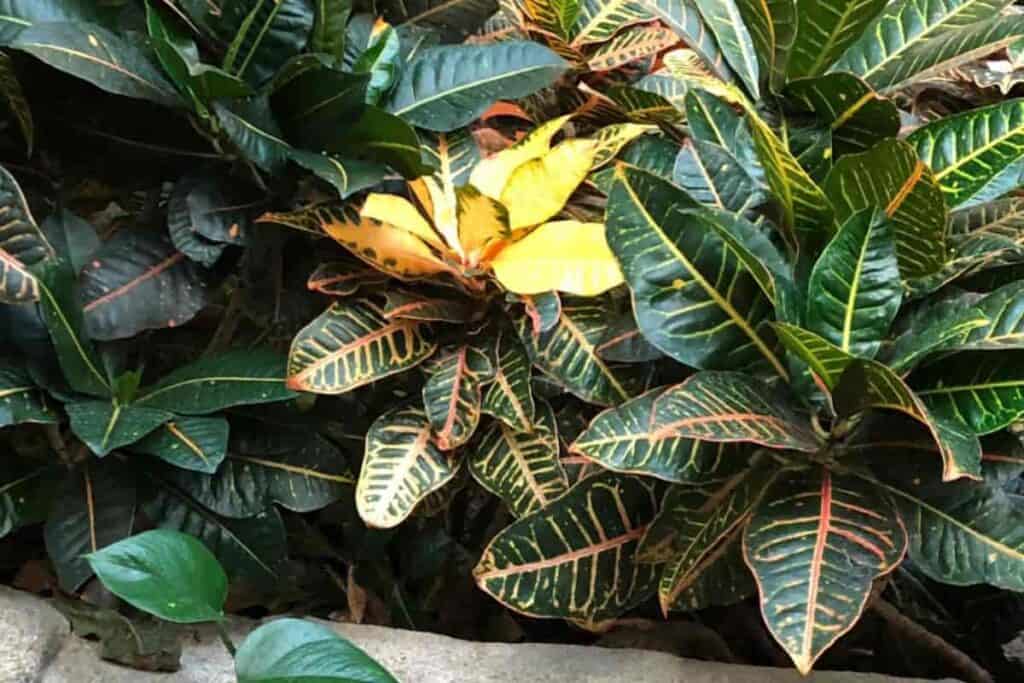The Croton (KROH-tun) genus is pretty massive, with approximately 1,150 species, and may be found throughout the tropics of the world.
Despite this, there’s a good chance that the croton you own or are planning to purchase is actually not croton at all, but a former member of the genus now classified as Codiaeum variegatum (koh-dih-EE-um var-ee-GAY-tum) and its many cultivars.

This latter plant is found natively throughout southeastern Asia and Australia and is also often referred to as the garden croton.
A perennial member of the Euphorbiaceae family, crotons have a reputation for being difficult to grow indoors but are actually far more tolerant than they’re given credit for.
Codiaeum Variegatum Care
Size And Growth
Crotons can be pretty slow growers, generally only gaining 1’ foot per year.
Outdoors, they can reach 10’ feet tall but will only reach up to 8’ feet indoors.
They tend to have ovate leaves, which can be orange, pink, purple, red, white, or yellow, with the variegation and colors often changing as the leaf ages.
Even on a single plant, these leathery leaves may vary widely, some being lobed and others having smooth or ruffled edges.
In warm enough temperatures, the plant is evergreen and leaves range in size from 2” to 12” inches long.
Flowering And Fragrance
Unfortunately, while outdoor croton may bloom all year long, bearing yellow to white flowers, plants kept indoors will rarely flower.
Since the plant is mainly kept for its leaves and the flowers are insignificant, most croton enthusiasts won’t even notice the loss.
Light And Temperature
Croton loves bright, indirect light.
Direct sunlight may scorch its leaves, and while it can survive in partial shade, the variegation will fade to a uniform green.
Avoid low humidity, as this can lead to an infestation.
A humidity level of 40% to 80% percent is recommended.
Misting is also recommended for this plant.
Temperature is where many people encounter problems.
Croton cannot handle temperatures below 50° degrees Fahrenheit and are best brought outdoors in only USDA hardiness zones 11 to 12 unless the temperature is carefully monitored.
Indoors, the plant prefers temperatures between 70° and 80° degrees Fahrenheit, and you should never allow it to be exposed to temperatures under 60° degrees Fahrenheit.
Avoid exposing it to drafts or sudden temperature shifts.
Watering And Feeding
Croton needs about 1” inch of water per week, but you can check the amount using the finger method.
Here are the steps to follow:
- Stick your finger into the soil at the base of the plant and water if it feels dry 2” to 3” inches down.
- Use the soak and dry method at room temperature with distilled water or natural rainwater.
- Cut back watering in winter to half as much.
- Use a liquid houseplant fertilizer with an NPK of 3-1-2 or 8-2-10 every other month from March through September, then stop for the dormant period.
Be sure to follow the instructions on the package to ensure your plant gets the right amount of food.
Soil And Transplanting
The soil for this plant needs to be acidic, loamy, and well-draining.
You may wish to amend the soil with organic compost and coarse sand.
The pH must be acidic and can range from 4.5 to 6.5
During its first three years, crotons need to be repotted annually in spring or early summer.
Afterward, only repot when the plant becomes root-bound (you’ll generally begin to see roots poking from the drainage holes or soil surface).
Grooming And Maintenance
This plant responds well to good pruning and may be cut back aggressively when it becomes leggy or you wish to maintain a specific shape.
Do your pruning at the beginning of its growing season and always cut just above a node or set of leaves.
Avoid cutting more than ⅓ of a stem during a specific pruning session.
How To Propagate Garden Croton
Stem cuttings are the best way to propagate your croton, and the process may be done at any time of year.
Croton Pests Or Diseases
Croton is very sensitive to cold and low humidity.
When faced with poor conditions, this plant is far more susceptible to pests and disease but is otherwise not particularly prone to problems.
Examples of the main disease risks include:
- Anthracnose
- Bacterial leaf spot
- Canker
- Crown gall
- Root rot
- Stem gal
Meanwhile, the most common pest problems are:
- Mealybugs
- Scale
- Spider mites
- Thrips.
Note that croton is toxic to humans and pets, and the sap contains latex, which can cause skin irritation or allergic reactions in sensitive individuals.
The seeds are potent enough that they can kill a child if ingested.
Codiaeum Variegatum Uses
Croton and its cultivars make for excellent seasonal accent plants if first acclimated to the outdoors before moving the container to a summer position.
They’re also excellent picks for well-lit foyers and reception areas.
They will need a spot with good lighting but bring a lot of color to the room.